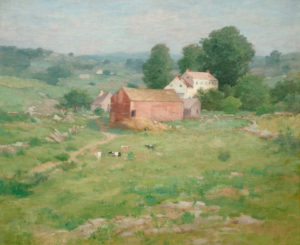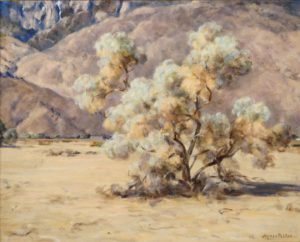Impressionist Landscapes from the Sellars Collection
Chan Gallery
January 31 – July 11, 2021

Charlotte Buell Coman, Quaker Hill, circa 1890, oil on canvas, 27.75 x 27.5 in.
With the acquisition of the Sellars Collection of Art by American Women in 2008, an important holding of paintings, drawings and sculptures was added to the Museum’s permanent collection. The Collection celebrates the achievements of American women artists active between 1850 and 1940, and provides a counterpoint to the Museum’s holdings of regionally and nationally significant contemporary art.
Impressionist Landscapes From the Sellars Collection focuses on the strong pull that the natural world had on American women artists during the late 19th and early 20th centuries. The exhibition emphasizes the generation of artists who emerged during and in the aftermath of the American Impressionist movement (1880-1920). Many of these artists were the students and sketching partners of the seminal figures in the development of Impressionism in America, such as William Merritt Chase, Willard L. Metcalf, John Henry Twachtman and Robert Henri.

Agnes Pelton, Old Smoke Tree, circa 1930, oil on canvas, 16 x 20 in.
The artists included in the exhibition were primarily concerned with capturing the effects of light, color, and atmosphere in their landscapes, achieved in large measure by painting directly from nature—out-of-doors—rather than in the studio. Though not as well-known as their Impressionist predecessors, this generation of landscape painters flourished in areas such Old Lyme, Connecticut; Cape Ann, Massachusetts; New Hope, Pennsylvania; and Woodstock, New York, as well as elsewhere in New England and across the Southwest.
Impressionist Landscapes from the Sellars Collection presents over 30 exquisite landscapes in all seasons, varying in scenic subject matter from snow-filled views to sun-drenched hillsides, as well as harbor scenes, woodland glades, and desert vistas. Featured artists include Irene Von Horvath, Edna Lawrence, Margaret Jordan Patterson, Alice Pelton, Lilla Cabot Perry, and many more.
This exhibition features a selection of paintings from the Sellars Collection that exemplify the strong effect that French Impressionism had on American art in the late 19th and early 20th centuries. The exhibition is focused on works that embody the early influence of French Impressionism and its precursor, the Barbizon Style, and adopt the various hallmarks of what became known as the American Impressionist style.
Thank you, Sponsors!
Drs. Kathy and Tony Chan

